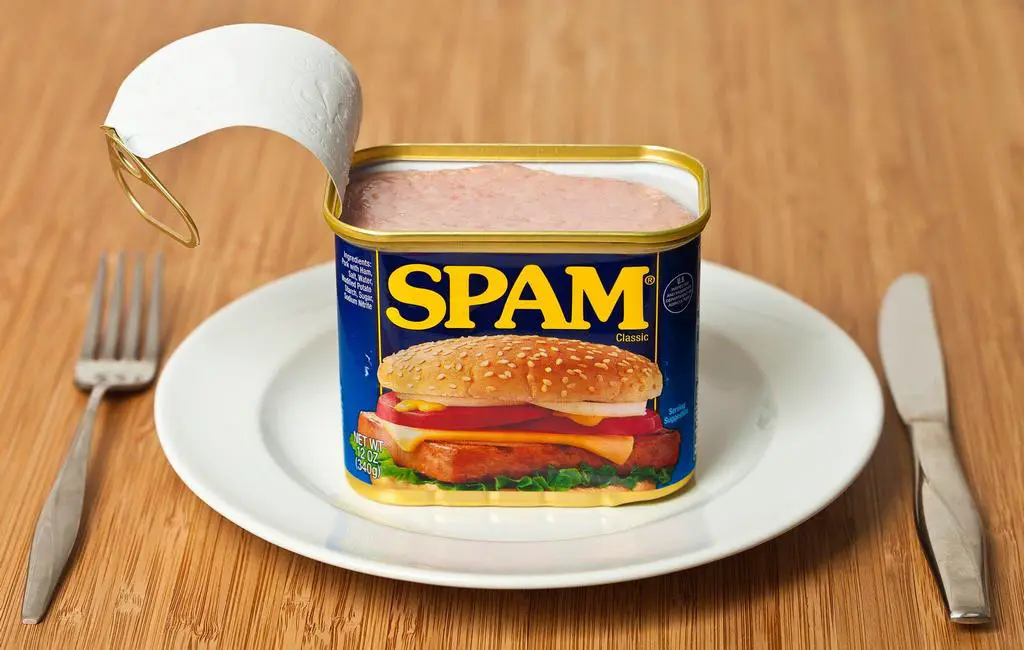Does Spam Have MSG? Why Does It Taste So Salty?

In the realm of canned meats, one name reigns supreme: Spam. Spam has a distinctive and unmistakable taste that some people love and others find objectionable. But have you ever wondered why Spam’s flavor is so salty and whether monosodium glutamate (MSG) plays a role in this culinary sensation?
In a world where food labels often read like secret codes, it’s not unusual to be skeptical about what’s hiding inside that iconic rectangular can. As we venture into the realm of spam, we’re not just looking at its ingredients but also the science and history that make it an enduring culinary enigma.
So, whether you’re a devoted spam enthusiast or just a curious food explorer, join us on this salty adventure. Get ready to uncover the truth about spam, one savory revelation at a time!
Let’s delve into the world of Spam, its ingredients, and the mystery of its salty goodness.
What Is Spam and Why Is It Popular?

Before we dig into the MSG connection, let’s talk about what makes Spam so enticing. But what exactly is spam? Well, it’s a processed combination of pork shoulder and ham (hence the name), mixed with salt, water, sugar, potato starch, and sodium nitrite for preservation.
For many, it’s nostalgia—a taste of childhood, a link to family traditions. For others, it’s the convenience of having a shelf-stable, ready-to-eat protein source in the pantry. But no matter why people enjoy Spam, the flavor is what keeps them coming back for more.
Spam, that ubiquitous canned meat product, has found its way into the hearts and stomachs of people around the world. While not everyone may find this concoction appealing at first glance, it is undeniably popular for several reasons.
One reason behind spam’s popularity lies in its versatility. Because of Spam long shelf life and ease of preparation, spam has become a go-to ingredient in various cuisines worldwide. From adding slices to breakfast sandwiches to incorporating it into stir-fries or even sushi rolls, spam can be adapted to countless dishes. Additionally, spam carries an affordable price tag compared to other meats, making it accessible to a wider range of consumers.
Another factor contributing to the appeal of spam is nostalgia. For many individuals who grew up eating this salty treat during times when resources were scarce or money was tight, it holds sentimental value. The familiarity and comfort associated with childhood memories make people nostalgic for those simpler times when indulging in a plateful of crispy fried spam was considered a treat.
Spam has a distinct savory and salty profile that sets it apart from other canned meats. The umami taste, which is often described as a rich and meaty flavor, is a big part of its appeal. And when we think of umami, MSG often comes to mind.
What Does Spam Taste Like?
If you’ve ever wondered what Spam tastes like, you’re in for a flavorful journey. This iconic canned meat boasts a distinct and undeniable savory profile with a generous pinch of saltiness.
The taste of Spam is often described as salty and savory, with a somewhat unique flavor profile due to its combination of ingredients. Some people enjoy its taste, finding it to be a convenient and versatile food, while others may find it to have an acquired taste.
But the magic of Spam doesn’t stop there. It’s a symphony of meaty goodness, as it combines various pork cuts with ham to create a unique blend of flavors that dances on your taste buds.
Now, when it comes to texture, Spam is no slouch either. Its consistency is often described as firm and slightly chewy, making it an all-arounder in the culinary world. Whether you’re slicing it thin for a sizzling pan-fry or cubing it for a hearty stew, Spam holds its own, maintaining that delightful texture that enhances a wide range of dishes.
So, if you’re thinking of trying Spam for the first time or exploring new ways to enjoy this iconic canned meat, its savory, salty, and versatile nature makes it a must-try ingredient in your kitchen.
Does Spam Have MSG? Unraveling the Ingredients
So, let’s get down to it. Does Spam have MSG? The short answer is yes. MSG is one of the ingredients in Spam, but it’s not the only source of its savory taste. Here’s a quick look at the key ingredients in a classic can of Spam:
| Ingredients | Function |
| Pork with ham | Provides the meaty base for Spam. |
| Salt | Enhances flavor and acts as a preservative. |
| Water | Moisture content to keep the meat tender. |
| Sugar | Adds a touch of sweetness to balance the salt. |
| Sodium Nitrite | Preservative and gives Spam its pink color. |
| Sodium Phosphate | Helps maintain the product’s texture. |
| MSG (Monosodium Glutamate) | Enhances the umami flavor. |
MSG is often the star of the umami show in many foods, and it plays a similar role in Spam. It’s a flavor enhancer that makes the savory taste of Spam more pronounced and satisfying.
The Magic of Monosodium Glutamate
MSG is a food additive that has been used for decades to boost the flavor of various dishes. It was first isolated from seaweed, and its discovery revolutionized the world of taste. MSG works by stimulating the umami receptors on our tongues, making food taste more delicious and savory.
While there have been some controversies surrounding MSG in the past, scientific research has not been able to conclusively link it to adverse health effects. In fact, the FDA (U.S. Food and Drug Administration) recognizes MSG as generally safe for consumption.
In Spam, MSG complements the natural flavors of the meat and amplifies the umami experience, giving it that distinctive, savory kick.
The Ingredients of Spam: Why It’s Salty.
Although Spam is known for its distinctive taste, many people wonder why it is so salty. The secret lies in its carefully crafted combination of ingredients. One of the main components contributing to the saltiness of Spam is sodium nitrite, a preservative commonly used in processed meats. This additive not only helps prevent bacterial growth, but it also enhances the flavor and color of the meat.
Another factor that adds to Spam’s saltiness is its high sodium content. A single serving can contain around 790 milligrams of sodium, which accounts for a significant portion of the recommended daily intake. The presence of both sodium nitrite and high levels of sodium creates an unmistakably salty profile in Spam.
Additionally, Spam contains other flavorful ingredients such as sugar and spices like garlic powder and black pepper that complement its savory taste. While some may find this saltiness overwhelming, others appreciate it as part of the unique appeal that has made Spam a beloved ingredient around the world.
The Health Concerns Associated With Eating Spam
Spam, that iconic canned meat product, has sparked debates about its potential health concerns. This meat may be a comfort food for some, but others worry about its high sodium and processed nature.
Studies have shown that excessive consumption of sodium can increase the risk of hypertension and other cardiovascular issues. Additionally, the high fat content in Spam can contribute to weight gain and increased cholesterol levels. It is crucial to note that moderation is key when it comes to indulging in this salty favorite.
Despite these health concerns, some argue that Spam can still have a place in a balanced diet. Moderation and portion control are vital aspects to consider when consuming any processed food item. Spam can be eaten healthier by choosing low-sodium varieties or combining it with whole grains and vegetables.
Balancing Act
Despite the saltiness, Spam’s creators have taken care to balance the flavors. The addition of a touch of sugar helps offset the salt and adds a hint of sweetness. This balancing act is what makes Spam’s taste so unique and pleasing to a wide range of palates.
Exploring Culinary Versatility
Spam’s savory, salty, and slightly sweet taste makes it a versatile ingredient in various dishes. From Spam musubi in Hawaiian cuisine to Spam and eggs for breakfast, its flavor profile works well in a variety of culinary applications. The umami boost from MSG, coupled with the saltiness, allows Spam to pair wonderfully with other ingredients.
The Bottom Line
So, to answer the question, yes, Spam does contain MSG, and it’s a key player in creating that savory, umami flavor that fans adore. But the salty taste that’s so characteristic of Spam primarily comes from the salt used in the product. The right balance of salt, sugar, and MSG is what makes Spam an enduring favorite in many households.
Whether you love it or remain skeptical, Spam’s unique taste is undeniably linked to its combination of ingredients. So the next time you savor a slice of this iconic canned meat, you’ll have a deeper understanding of why it tastes the way it does – a harmonious blend of savory, sweet, and salty, with a hint of umami.
FAQs on Is there MSG in Spam
Is Spam bad for you?
Moderation is key. While Spam can be high in sodium and fat, occasional consumption is unlikely to cause harm. However, regular intake may contribute to health issues such as heart disease and high blood pressure. It’s advisable to balance its consumption with a diet rich in fruits, vegetables, and whole grains.
Can you eat Spam raw?
No, it is not recommended to consume Spam raw. It is a processed meat product that requires cooking before consumption to ensure food safety and eliminate any potential risks associated with consuming raw meat.
How is Spam made?
Spam is made by combining chopped pork shoulder meat, ham, salt, water, sugar, and sodium nitrite, among other ingredients. These are ground together into a fine mixture, which is then canned and cooked through a specialized process to ensure preservation.
Is Spam processed meat?
Yes, Spam is classified as a processed meat product. It undergoes various procedures, such as curing, smoking, or canning, to extend its shelf life. Regular consumption of processed meats has been associated with certain health risks, highlighting the importance of moderation.
What are the different flavors of Spam available?
Some popular flavors of Spam include Classic, Low Sodium, Turkey, Hickory Smoke, and Hot & Spicy. These variations cater to diverse taste preferences and provide options for consumers looking for specific dietary choices.
Can Spam be used in vegetarian dishes?
While Spam is a meat-based product, there are vegetarian alternatives available on the market that mimic its taste and texture. These substitutes can be used in recipes to create vegetarian versions of dishes traditionally made with Spam.
How does Spam fit into different culinary cultures globally?
Spam has integrated into various culinary cultures globally, from being a breakfast staple in Hawaii to a popular ingredient in Korean cuisine. Its versatility allows it to be adapted to different flavor profiles, making it a unique and versatile ingredient in global culinary traditions.






